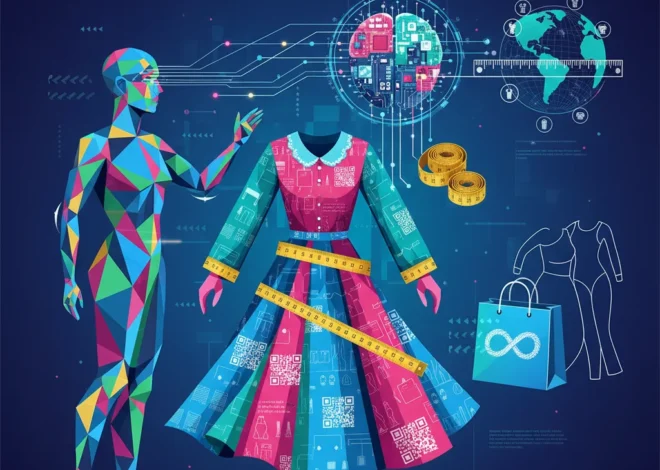
The End of “What’s My Size?”: How AI is Tailoring the Future of Fashion
We’ve all been there. Staring at an online size chart that feels more like an ancient, cryptic text than a helpful guide. You’re a size 10 in one brand, a 14 in another, and a “medium” in a third. This sizing chaos isn’t just a personal frustration; it’s a multi-billion-dollar problem plaguing the fashion industry, leading to mountains of returned clothes and a significant environmental footprint. But what if the solution wasn’t a better chart, but smarter technology? A recent BBC “Tech Now” feature highlighted the very real possibility that our sizing woes could soon be a thing of the past, thanks to a new wave of startups leveraging artificial intelligence.
This isn’t just about convenience. It’s a fundamental shift in how we interact with fashion, powered by sophisticated machine learning algorithms, cloud computing, and a drive for sustainable innovation. Let’s unravel the threads of this technological revolution and see how AI is stitching together a better future for our wardrobes.
The Seams Are Coming Apart: Unpacking Fashion’s Sizing Crisis
The problem of inconsistent sizing is a complex tapestry woven over decades. In the mid-20th century, standardized sizing was introduced, but over time, brands began engaging in “vanity sizing”—the practice of labeling clothes with smaller sizes than their actual measurements to flatter consumers. A size 8 dress from the 1950s is drastically smaller than a size 8 today. This, combined with a lack of global standards and fast fashion’s rapid production cycles, has created a full-blown crisis.
The consequences are staggering. The e-commerce fashion industry sees return rates as high as 40% (source), with “poor fit” being the number one culprit. These returns aren’t just a logistical headache; they represent a massive financial drain and an environmental disaster.
- Economic Impact: Processing returns is expensive. It involves shipping, inspection, restocking, and often, liquidation or disposal. This reverse logistics chain eats directly into a retailer’s profits.
- Environmental Cost: Every return doubles the carbon footprint of an item’s journey. Worse, many returned items, especially from fast-fashion brands, are not in perfect condition for resale and end up in landfills, contributing to the estimated 92 million tons of textile waste generated each year (source).
- Customer Frustration: A bad fit leads to a poor customer experience, eroding brand loyalty and reducing the likelihood of future purchases. The cycle of ordering multiple sizes and returning most of them is a frustrating and wasteful process for everyone involved.
This is precisely the problem that visionary tech startups are setting out to solve. They’re not trying to standardize the brands; they’re trying to standardize the recommendation for you.
Beyond the Billions: How Elon Musk's "Frugal" Lifestyle Fuels a Revolution in AI and Tech
The Digital Tailor: How AI and Machine Learning Create the Perfect Fit
So, how exactly does an AI system replace a measuring tape and a prayer? The technology is a fascinating blend of data science, computer vision, and predictive analytics, often delivered as a seamless SaaS (Software as a Service) solution for e-commerce sites.
1. Data Collection: The Foundation of Fit
An AI model is only as good as its data. These systems are trained on massive datasets containing two key types of information:
- Garment Data: Detailed technical specifications for every single item a brand sells—not just “small, medium, large,” but precise measurements of the chest, waist, inseam, sleeve length, and even the fabric’s stretch properties.
- Body Data: This is the tricky part. It can be gathered in several ways, from simple user inputs to advanced scanning:
- Basic Inputs: Users provide their height, weight, age, and sometimes their size in a brand they know fits them well.
- Computer Vision: The most advanced solutions use a smartphone’s camera. A user takes a couple of photos or a short video, and the AI’s computer vision algorithms create a precise 3D body model, extracting dozens of key measurements in seconds.
2. The Machine Learning Core
Once the data is in, the machine learning model gets to work. Using complex regression and classification algorithms, the system cross-references the user’s unique body measurements with the specific garment’s data. It doesn’t just match numbers; it predicts how the fabric will drape and stretch on that individual’s body shape. The result? A highly accurate size recommendation, like “We recommend a Size 12 for a snug fit, or a Size 14 for a looser feel.” This entire computational process happens in the cloud, delivering a result to the customer in milliseconds through clever programming and API calls.
From Chaos to Clarity: The AI-Powered Advantage
The implementation of this technology creates a powerful win-win-win scenario for consumers, retailers, and the environment. The contrast between the traditional shopping experience and an AI-enhanced one is stark.
Here’s a comparison of the old way versus the new, AI-driven approach:
| Aspect | Traditional E-Commerce | AI-Powered E-Commerce |
|---|---|---|
| Sizing Method | Static, generic size charts; customer guesswork. | Dynamic, personalized size recommendations based on body data. |
| Customer Confidence | Low. Often results in “bracketing” (buying multiple sizes). | High. Customers trust the data-driven recommendation. |
| Return Rate | High (20-40% in fashion). | Significantly reduced, leading to lower operational costs. |
| Data & Insights | Limited to sales and return data. | Rich, anonymized data on customer body shapes, informing future design and inventory. |
| Environmental Impact | High due to reverse logistics and waste from returned goods. | Lowered carbon footprint and less textile waste. |
This level of automation and personalization is a quantum leap forward. For retailers, it’s not just about cutting costs; it’s about gathering invaluable, anonymized data about their customers’ true shapes and sizes, which can inform future design, manufacturing, and inventory decisions. This is the kind of deep innovation that can reshape an entire industry.
Beyond the Hype: Is Elon Musk's Optimus Robot the Future of Everything?
Navigating the Hurdles: Ethics, Bias, and Integration
While the promise of AI in fashion is immense, the path forward is not without its challenges. For this technology to become mainstream, developers, entrepreneurs, and brands must navigate several critical hurdles.
Cybersecurity and Data Privacy
As mentioned, we’re talking about highly personal data. Startups in this space must invest heavily in state-of-the-art cybersecurity to protect against breaches. Transparency is key. Users need to know exactly what data is being collected, how it’s being stored (and for how long), and who has access to it. Compliance with regulations like GDPR and CCPA is the absolute minimum requirement. The data must be anonymized and encrypted both in transit and at rest, a significant challenge that requires expert-level programming and architecture.
Algorithmic Bias
An AI is only as unbiased as the data it’s trained on. If a machine learning model is trained predominantly on one body type or ethnicity, its recommendations may be less accurate for others. It is ethically imperative for developers to ensure their training datasets are diverse and representative of the global population to avoid perpetuating biases and creating a frustrating experience for underrepresented groups.
Seamless Integration
For a retailer to adopt this technology, it must be easy to integrate. The ideal solution is a lightweight SaaS plugin that can be added to existing e-commerce platforms like Shopify, Magento, or Salesforce Commerce Cloud with minimal custom development. The user experience must be frictionless, adding a clear benefit without slowing down the path to purchase.
The AI We Have vs. The AI We Need: A Stanford Economist's Urgent Warning
A Perfectly Fitted Future
The frustration of erratic clothing sizes may finally be meeting its match. The convergence of artificial intelligence, cloud computing, and a new generation of tech startups is paving the way for a more personalized, efficient, and sustainable fashion industry. As highlighted by the BBC, this innovation is no longer a distant dream but a present-day reality for a growing number of forward-thinking brands.
By transforming a point of friction into an opportunity for engagement, AI-powered sizing tools are doing more than just selling clothes—they’re building trust, reducing waste, and tailoring the shopping experience to the one person that matters most: you. The next time you shop online and see a button that says “Find Your Perfect Fit,” you’ll know it’s not a gimmick. It’s the powerful result of sophisticated software working to make your life just a little bit easier, one perfectly fitted garment at a time.
